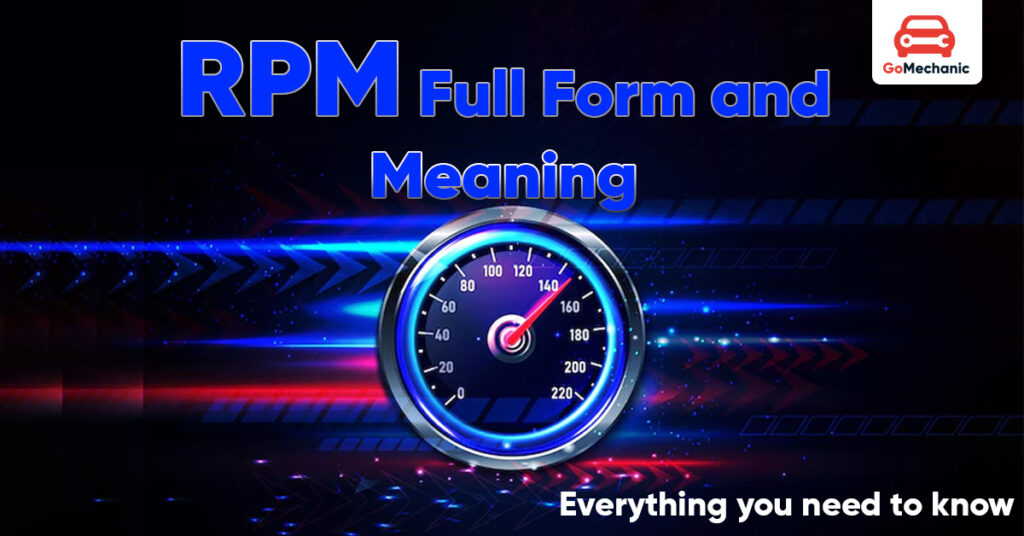Like counting the breaths of an engine, RPM, which is an acronym for Revolutions Per Minute-offers an analogy to read the catalyst of cars, the heartbeat of an engine. It is the most concise concept that establishes the track of crankshaft rotations every minute, offering a factual update through which a more in-depth understanding can be made available of the operation of the vehicles themselves. Monitoring RPM while accelerating, cruising, or idling could help optimize one’s performance of driving and maintenance of the engine’s good health. In this blog we will talk about RPM full form its meaning factors controlling it, its flycatiations a few more concepts about it. Let’s delve a lot deeper into the relevance of this reading.
RPM Full Form and Meaning
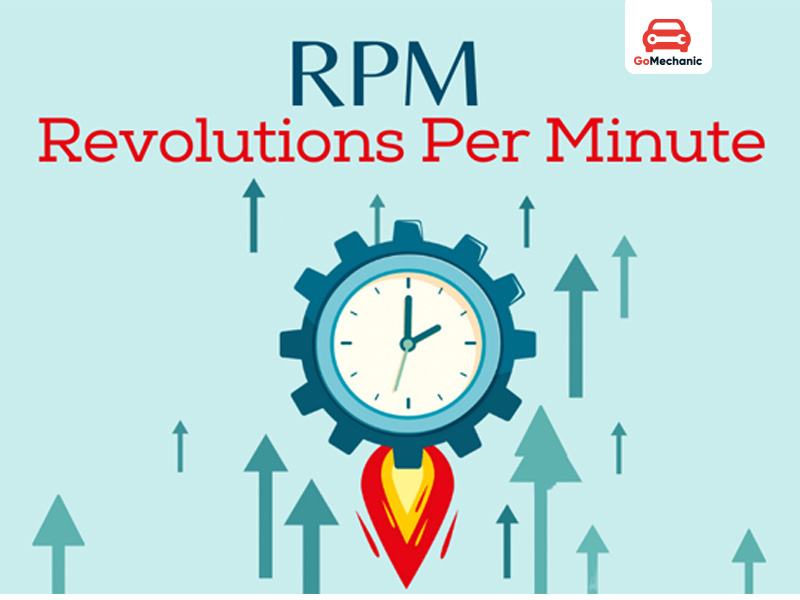
RPM full form is Revolutions per Minute, this is how many times the crankshaft in an engine completes a whole rotation in one minute. It’s like your engine’s “breaths.” Understanding this is crucial as, at any given point of time, it reveals the difficulty or otherwise of an engine having been functional. More RPMs indicate overwork, too much power, and the requirement of increasing RPM levels during sudden acceleration or start-up at inclines. Optimum RPM should establish for the smooth running of the engine, excellent power delivery, and good fuel economy. Monitoring RPM may reveal any early problems, such as unusual fluctuations or inefficiencies. Whether a person is navigating through city traffic or rushing faster on a highway, RPM is an effective check for the well-being of one’s engine and, ultimately, a person’s capability to decide better about driving.
Before you know what is RPM in car, it is important to understand how it is measured.
How Is RPM Measured?
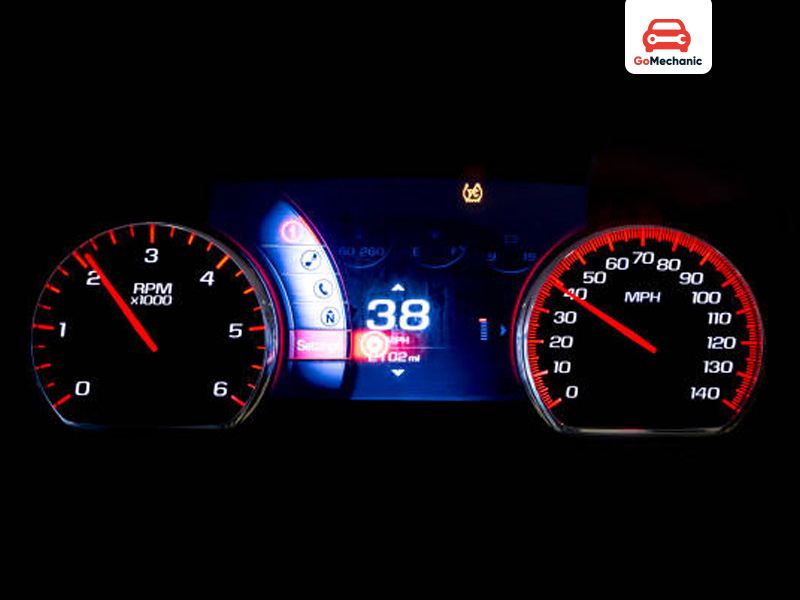
- Dashboard Display: The tachometer on the dashboard is the usual place for the RPM to be shown in a car; it is a special type of gauge which measures engine speed.
- Real-Time Feedback: Drivers can keep an eye on real-time RPM levels using the tachometer — this tells them how hard the engine at the moment.
- Redline Marking: Subsequently, the tachometer also has a redline marking that reminds the driver of the highest safe limit that the RPM can reach. If you overstep this limit, the engine might incur a considerable amount of damage.
- Maintenance and Tuning: Specialists use various diagnostic tools during regular RPM-based engine tuning to get a perfect and detailed reading of the RPM measurement.
- Engine Health Monitoring: By observing the tachometer, the driver sees when the engine is working at its best and avoids the unnecessary stress on the engine.
Do Read: How Does a Car Engine Work?
How Does RPM Work With an Engine?
RPM measures the speed at which the crankshaft rotates, pushing the pistons in an engine. Pressing down on the accelerator opens up the throttle, letting more air and fuel into the combustion chamber. Combustion increases as a result, increasing power, raising the RPM. How well an engine converts its fuel into a rotational force will depend on how it is constructed, including how many cylinders are in the engine, its compression ratio, and how the valves operate at different RPM. Lower RPM generally offers smoother and fuel-efficient operation, while higher RPM delivers more power but at the cost of greater fuel consumption and engine stress.
Factors Controlling RPM in a Car Engine
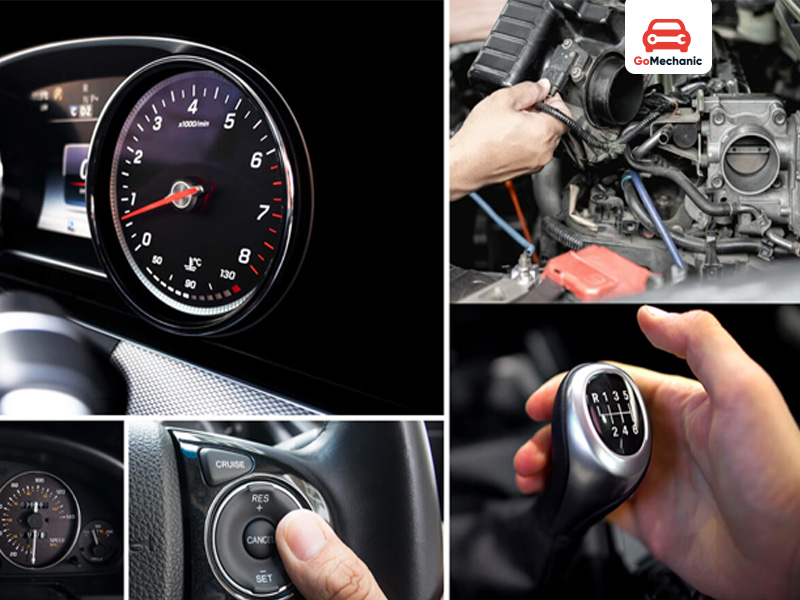
There are several factors which regulate RPM, determining sink in operating capabilities of the engine under different conditions. Let us discuss all the major elements one by one:
The throttle is perhaps the first factor to consider while considering the RPMs. It modulates the air-fuel mixture coming into the engine by opening or closing itself. By opening, it permits a wider path for the air and fuel mixture to enter into the engine; when this happens the rate of combustion increases, so does the RPM.
The engine load can be defined as the amount of work the engine is doing. For example, towing a trailer, climbing up steep inclines, or even accelerating rapidly are tasks that make the engine work more and increase its RPM. Conversely, driving on a flat terrain or cruising at a steady speed reduces strain on the engine and lowers RPM levels.
The gear ratio affects the RPM directly because it controls how power is delivered to the wheels. Lower gears make the engine spin faster to generate torque for acceleration or uphill driving, thus higher RPM. In contrast, higher gears allow the engine to work at a slower speed while keeping the momentum of the vehicle, thus lowering the RPM. Therefore, proper gear selection is necessary for optimal performance and fuel efficiency.
Designing an engine plays a major role in its RPM capacity. Such features as cylinder arrangement, displacement, compression ratio, and valve timing decide at what RPM levels how much power the engine can produce. For example, the engine of a high-performance sports car is built to be operated at higher RPM levels to provide maximum power, whereas the diesel engine is optimized for low RPM operation in order to have good torque and efficiency.
Related: The Role of Coolant in Car Engine Health and How to Maintain It
External factors like temperature, altitude, and humidity can also influence RPM. In colder temperatures, the engine may need higher RPM during warm-up to maintain optimal performance. At higher altitudes, reduced oxygen levels can affect combustion efficiency, causing changes in RPM. Similarly, high humidity or extreme heat can impact engine performance, indirectly altering RPM levels.
Why Is RPM Important to the Performance of Your Car?
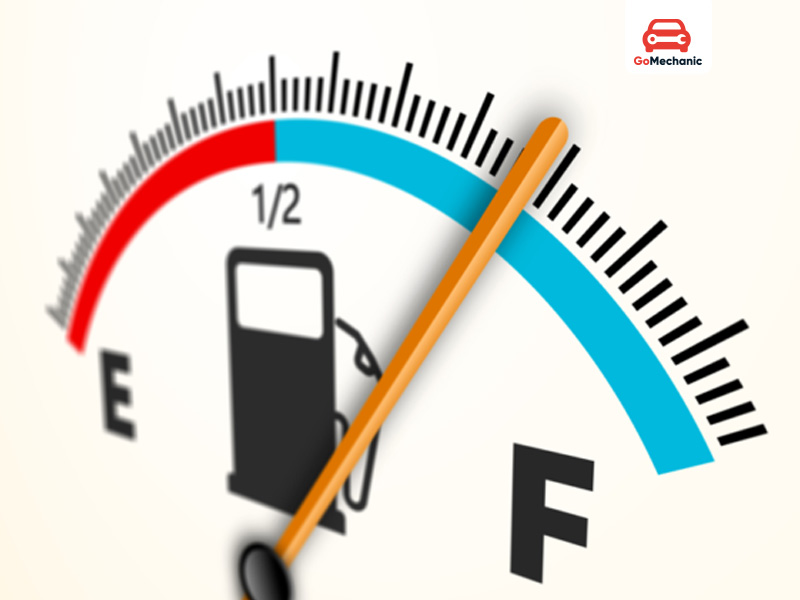
RPM, simply put, is not a number on the dashboard but a vital indicator of your car’s performance. It affects several significant things in the way that your vehicle is designed to run, so careful monitoring and management of RPM levels is essential.
- Acceleration: Higher RPMs have to do with operating harder and producing more power. This is very important for acceleration and overtaking and generally climbing steep inclines.
- Fuel Efficiency: To maintain the most optimal RPM is to keep it running in the most efficient range; this will prevent fuel consumption at its best. Stay out of extremes, either too high or too low, will save fuel in the long run.
Also Read: The 10 Best Mileage (Most Fuel Efficient) Diesel Cars Of 2024-25
- Engine Longevity: Running the engine at an extremely high or low RPM will put undue pressure on the engine and make it wear out before its time. A balanced RPM would keep the engine healthy for a longer period.
- Driving Dynamics: Smoothness and responsiveness while driving are a result of balanced RPM. It can affect how fast the car can accelerate, change gears, and handle various road conditions.
Common RPM-Related Issues in Cars
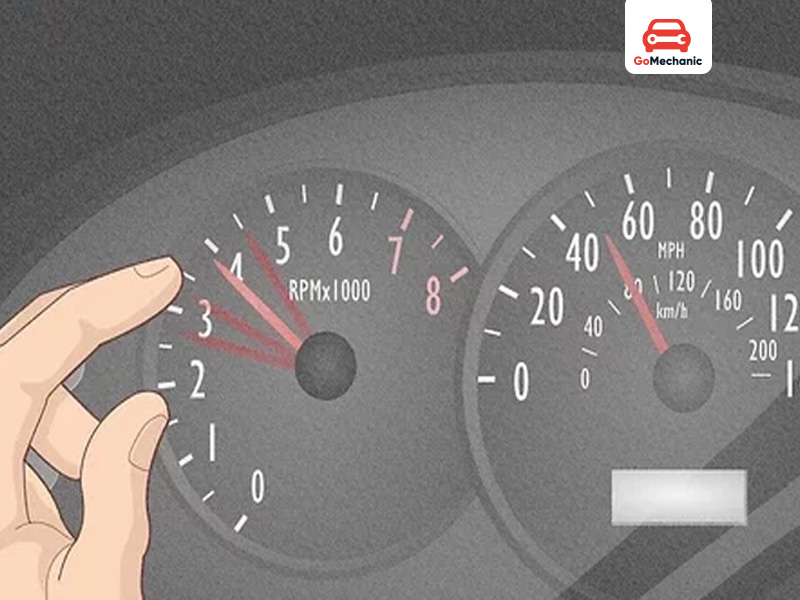
Problems with RPM can present as performance problems, which, if not corrected, can cause serious engine problems. Some of the common RPM-related problems include:
- Idle Fluctuations: A needle that bounces or fluctuates during idling often points to issues like a vacuum leak, malfunctioning sensor, or idle control system problem. This can make the car feel unstable when stationary.
- Stalling: When the RPM drops to low, the engine tends to stall especially during idle. It results from poor delivery of fuel and ignition. Mostly, this may be attributed to a faulty throttle body.
- Misfires at High RPM: Poor spark plugs, or improper distribution of fuel at higher speeds may trigger misfires due to problems within the ignition system, leading to poor performance, and eventually damage.
- Mechanical or Electrical Limitation: For instance, the ECU may have a malfunction, or a worn-out component may restrict the max RPM to which the engine might otherwise be capable, thereby limiting its performance potential.
Understanding the importance of RPM and recognizing issues early can help maintain your car’s performance, improve fuel economy, and prevent costly repairs. Regular monitoring and prompt attention to unusual behavior in RPM levels are key to ensuring a smooth and efficient driving experience.
Practical Tips to Keep your RPMs Healthy

It’s important to ensure that your car runs efficiently with minimal wear and tear, making it operate properly. Here are some tips that can be really helpful to get your engine at its peak levels:
- Scheduled Servicing: Sticking to a recommended schedule as per the manufacturer’s guidelines ensures smooth running and performance. Spark plugs, fuel injectors, sensors, and others need servicing as well to provide the perfect levels of steady-running RPM.
- Ride Smootly: Avoid sudden acceleration or abrupt gear changes, as these can cause unnecessary RPM spikes. Smooth and gradual inputs on the throttle and brake reduce strain on the engine and improve fuel efficiency.
- Use the Right Gear: Always choose the right gear for the driving conditions. In manual transmissions, proper gear shifting at the correct RPM would never cause over-revving or engine lugging, while in automatic cars, driving should not be too harsh to allow the transmission to work properly.
- Check Fluids Regularly: Coolant and enough engine oil ensure there is adequate fluid, thereby preventing overheating and friction in the engine, which leads to high optimum RPM.
- Problems Must be Solved Immediately: If you notice any of the following behaviors in your car’s RPM—fluctuations, stalling, or erratic idling—see a mechanic right away. Early diagnosis and repair can prevent minor issues from escalating into major engine problems.
How Does RPM Affect Car Performance?
RPM, or revolutions per minute, is a very important metric that directly affects your car’s performance, fuel efficiency, and engine longevity. Its impact varies between a manual and an automatic car, as each needs to be handled differently for maximum performance. Let’s break it down further.
Impact of RPM on Performance
| Aspect | High RPM | Low RPM |
| Acceleration | Delivers more power for quicker acceleration, useful for overtaking or climbing inclines. | Provides less power, which may not be sufficient for rapid speed changes or challenging terrains. |
| Fuel Efficiency | Reduces fuel efficiency as the engine works harder and consumes more fuel. | Enhances fuel efficiency by operating within the engine’s optimal range. |
| Engine Longevity | Causes wear and tear if sustained for long periods, potentially shortening engine life. | Reduces engine strain, extending lifespan when maintained within an efficient range. |
| Driving Dynamics | Can cause the ride to feel aggressive or harsh. | Provides a smoother and more controlled driving experience. |
RPM Considerations for Manual and Automatic Cars
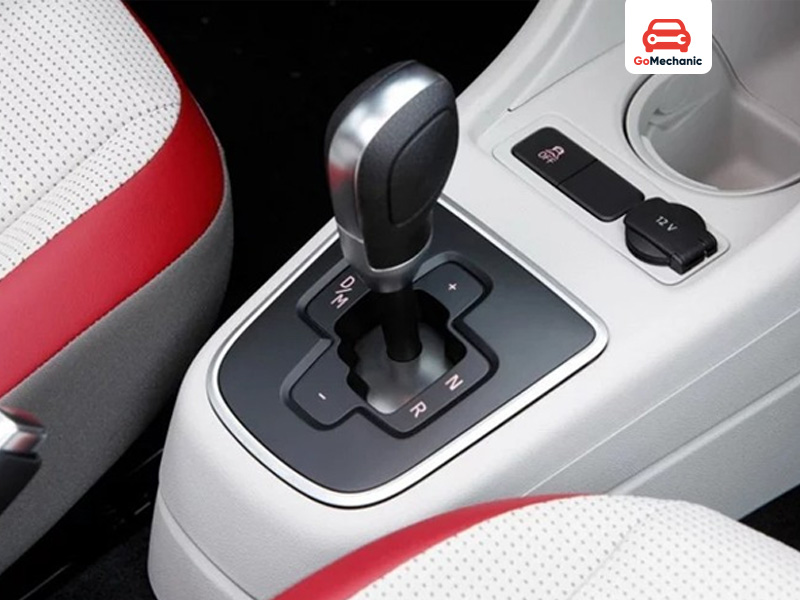
Manual Cars
- In manual transmission cars, the management of RPM is highly dependent on the driver’s skill and knowledge of gear-shifting techniques.
- Gear Shifting: Shifting gears at the right RPM is important to avoid over-revving (which wastes fuel) or lugging the engine (operating at too low RPM).
- Optimal RPM for upshifting: Usually between 2,500–3,000 RPM.
- Optimal RPM for downshifting: Usually below 1,500 RPM, depending on the speed and gear.
- Control: The driver has complete control over RPM, so monitoring the tachometer is essential for smooth transitions and optimal performance.
- Efficiency Tip: Do not ride the clutch or skip gears. Both of these habits can throw off the balance of the engine’s RPM and lower efficiency.
Automatic Cars
- Automatic cars take care of RPM and gear shifts for the driver, using information from the accelerator and driving conditions.
- Smooth Shift: The transmission shifts automatically to keep the RPM in a sweet spot, which is 1,500–2,500 RPM for regular cruising.
- Driver Action: Aggressive acceleration will increase the RPM while cruising steadily and will maintain it around lower numbers for better fuel efficiency.
- Convenience Tip: If fitted, employ the ecu mode or comfort mode to have the vehicle keep the RPM as low as possible for fuel-saving purposes as well as minimize wear.
Optimal RPM Range for Performance
| Driving Condition | Manual Cars (RPM Range) | Automatic Cars (RPM Range) |
| Idling | 600–1,000 RPM | 600–1,000 RPM |
| City Driving | 1,500–2,500 RPM | 1,500–2,500 RPM |
| Highway Cruising | 2,000–3,000 RPM | 1,800–2,500 RPM |
| Overtaking/Acceleration | 3,000–5,000+ RPM | 3,000–5,000+ RPM |
Key Takeaways
- RPM management is more hands-on in manual cars, requiring attentive gear-shifting to maintain optimal performance.
- Automatic cars simplify RPM control, but aggressive driving can still lead to inefficient RPM use.
- Always aim to drive within the car’s optimal RPM range to ensure better fuel economy, smoother handling, and longer engine life.
What is a typical RPM Range for Cars?
Usual operating range in RPM for a car is between 600 to 1,000 for idling and between 1,500 and 3,000 under normal driving conditions. At an idle, the engine should be run relatively straight with very few jumps, and under the condition of acceleration or at high speed, the RPM will jump higher in relation to the size of the engine and associated load. For most modern cars, the tachometer red line begins at the 5,500 to 7,000 mark, marking the safe operating range. Crossing this threshold might damage the engine, and staying within the prescribed RPM is thus important to preserve performance and safety.
What is RPM Fluctuation and How to Fix It?
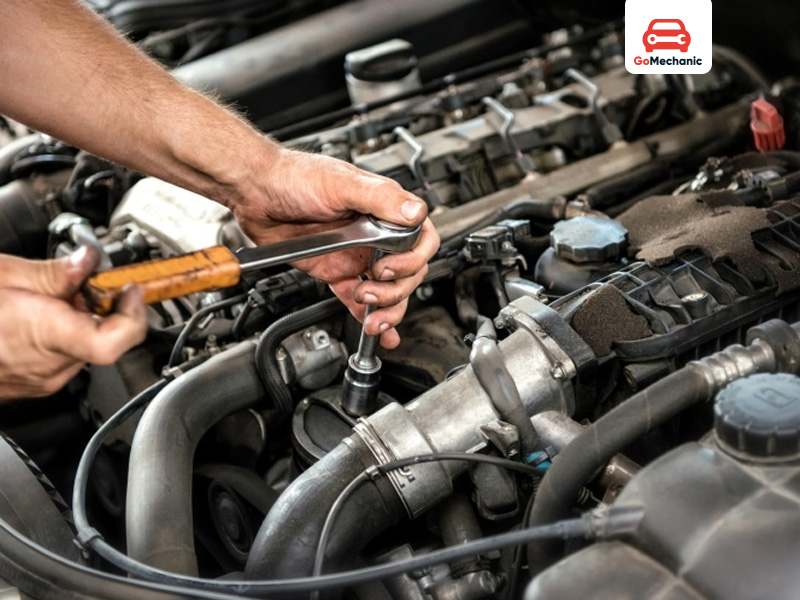
Idle rpm can wander and/or fall and climb while driving. In other words, the variation is not regular but erratic and often quite steep when the vehicle is idling or being driven. The problem sometimes arises when it has vacuum leaks at the intake manifold, a faulty sensor, or an operative idle air control valve. This results in lesser fuel economy, stalling, and even engine breakage; or perhaps misfires. The best is to solve it as it occurs.
- Clean Throttle Body: Carbon buildup within the throttle body can cause improper airflow, hence RPM variation. Cleaning it restores proper functionality.
- Inspect Sensors: Faulty MAF or oxygen sensors can upset the air-fuel mixture causing variation. Replace the faulty sensor.
- Inspect the idle air control valve: Check whether the idle control valve is dirty or damaged, the unstable RPM can be caused by this.
- Inspect the Fuel System: Check if the injectors and the fuel pump are functioning well. The injector may get blocked or become weak, meaning it may require a service or replacement.
- See a Mechanic: If the problem persists, a professional diagnosis can identify hidden problems such as ECU malfunctions or more serious engine problems.
How to Keep an Eye on RPM Gauge for Optimum Performance?
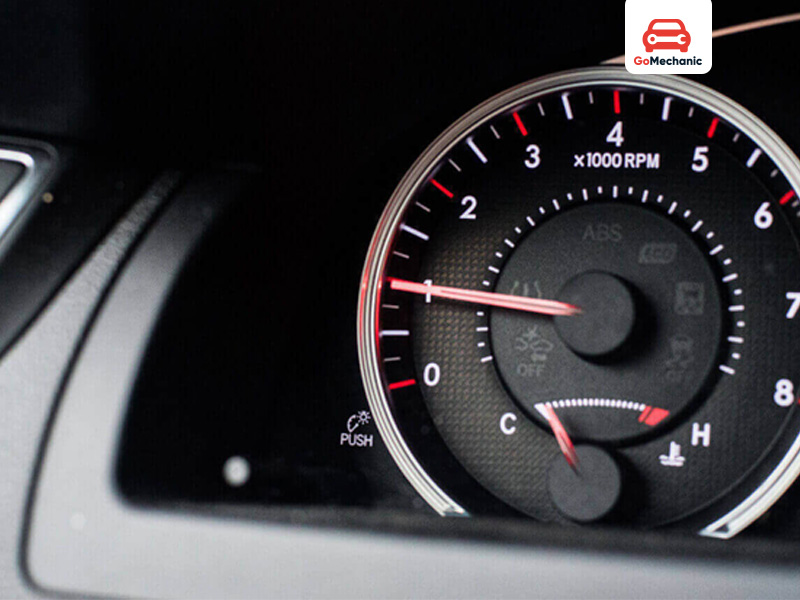
Monitoring your RPM gauge is necessary to optimize performance and prevent devastating damage to your engine.
- Monitor the Tachometer: Avoid redline zones, as operations can lead to engine strain or damage.
- Shift Gears Properly: With manual transmission, shift gears at an optimal RPM to ensure a smooth transition while experiencing maximum power output.
- Drive Smoothly: Steer clear of sudden accelerations and decelerations, which lead to sharp leaps in the RPM.
- Maintain Constant RPM: When driving on highways, keep your car cruising at a constant RPM to increase the mileage and the ride quality.
- Monitor Anomalies: Any kind of unusual or rapid variation in RPM might point towards an underlying problem.
Keep your eyes on your tachometer, know what to look for, and your ride will not only improve in terms of performance and mileage but also live a long life. Keep the irregularities addressed on time so you don’t end up with high repair costs.
Conclusion
RPM—Revolutions Per Minute is much more than just a technical term. It’s the rhythm dictating your car’s health, performance, and efficiency. Know what is RPM in a car, monitor it regularly, and keep it within optimal limits; it will be a great asset to your vehicle’s lifespan as well as your driving experience. But whether you’re speeding down the highway or cruising down the city streets, keep tabs on your car’s RPMs and enjoy smooth, efficient, worry-free rides. The next time you look at your tachometer, remember-this is more than a gauge; it’s the heartbeat of your engine!

